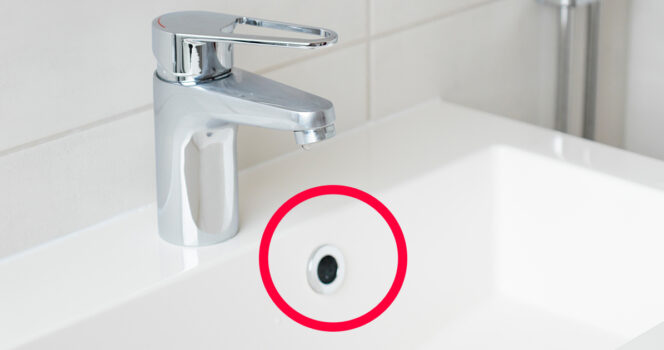
If you’ve ever accidentally left your bathroom tap running, this handy little feature in the basin of your sink has likely saved you from having to clean up a soggy mess.
Though it’s often unappreciated, the extra hole in your porcelain bowl plays a very important role in how your bathroom functions and it also helps prevent flooding.
Keep reading to learn more!
Though several people, and some creatures, find various purposes for the holes found on the upper wall of the basin, they actually serve as an important safety feature.
Since the late 1800s and early 1900s, sink designs began to include overflow holes, a crucial inclusion to make the plumbing system more efficient, and to prevent water damage in homes.
Throughout the 20th century, the design and placement of overflow holes became standardized in many sink and bathtub types, and today, while many modern sinks still feature overflow holes, some minimalist designs choose to forgo them for aesthetic reasons.
However, most bathroom and kitchen sinks, especially those intended for everyday use, still include this important safety feature.
Primary functions
The engineering behind this feature helps maintain both safety and functionality in bathroom and kitchen sinks.
The overflow hole has two primary functions:
Manages water levels in the sink: The holes channel excess water away before it spills over the edge. When the water level reaches the overflow opening, it diverts the excess through a separate drainage pathway, which bypasses the sink stopper.
However, it’s important to note that while the overflow can delay spills, it isn’t a foolproof solution. If a faucet is running at full volume, the water can still exceed the overflow’s capacity, leading to potential spills. This limitation emphasizes the importance of monitoring water levels and not leaving faucets running unattended.
It’s a smart safeguard, but it works best as part of a broader approach to responsible water use.
Allows water to drain more efficiently: Overflow holes provide a pathway for air to enter the drainpipe, which helps balance the pressure and prevents the suction that can slow down water flow. When water covers the drain opening, it can create a vacuum effect, leading to slower drainage and the formation of air bubbles.
These holes allow water can drain more freely and they reduce the risk of clogs or slow drainage.
Essentially, overflow holes enhance the overall efficiency of the sink’s plumbing by allowing for better ventilation and smoother water removal.
Where does the water go?
According to The Spruce, a standard overflow connects to a hidden channel runs along the underside of the sink basin, making it largely invisible from both above and below.
The overflow typically has one or two holes near the rim that allow water to enter the channel when the water level gets too high. This channel then directs the excess water to an outlet hole that drains into the main plumbing system. Since the overflow operates independently of the sink stopper, it remains open at all times, ensuring that any water that might otherwise spill over is effectively redirected to the drain.
How to clean an overflow hole
Keeping the sink overflow clean is essential for proper drainage and preventing unpleasant odors. It also
Here are several effective methods to manually clean the overflow:
- Use a Flexible Brush: A long, flexible brush, like a bottle brush, can reach deep into the overflow channel. Gently insert it and scrub the sides to remove any buildup.
- Vacuum with a Hose Attachment: If you have a wet/dry vacuum, use it with a hose attachment to suck out any debris from the overflow. This can be particularly effective for larger clumps of gunk.
- Soak with Vinegar and Baking Soda: Pour a mixture of vinegar and baking soda down the overflow. Let it sit for about 15-30 minutes to break down any gunk, then flush it out with hot water.
- Use a Pipe Cleaner: For smaller clogs, a pipe cleaner can be very effective. Twist it gently inside the overflow to dislodge debris.
- Rinse with Hot Water: Regularly flushing the overflow with hot water can help prevent buildup. Use a kettle or a pot to carefully pour hot water down the channel.
- Regular Maintenance: Make it a habit to clean the overflow every few months. This proactive approach will help prevent larger issues down the line.
Did you know the purpose of these extra holes in your sinks? Please share your thoughts with us and then share this story so we can hear from others!
READ MORE
- Homeowner surprised by strange object with shiny little teeth under kitchen cabinet
- Woman finds tiny tub in centuries-old house, shocked to learn its purpose




